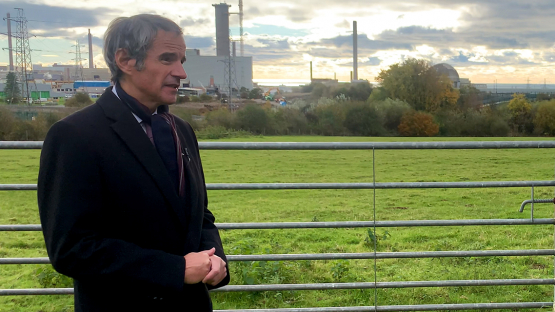Well-planned decommissioning of nuclear facilities and effective waste management are necessary for the sustainability of nuclear energy, IAEA Director General Rafael Mariano Grossi said today at the Sellafield site, home to the world’s first commercial reactor and now the centre of the United Kingdom’s decommissioning efforts. He visited the site during the UN Climate Change Conference in Glasgow, where an IAEA delegation is highlighting nuclear power’s role to achieve carbon neutrality.
“Nuclear energy provides 15% of the UK’s electricity, amounting to almost 40% of the country’s clean electricity,” Mr Grossi said. “And the UK is building a new generation of reactors to be the cornerstone of a Net Zero energy system with solar and wind that will get the country to carbon neutrality by 2050.”
At the end of their service life, nuclear reactors and other facilities need to be decommissioned – taken apart safely and securely, so that their sites can be used for other purposes.
“Sellafield is also an example of how the nuclear industry safely and responsibly manages its waste, from cradle to grave,” Mr Grossi said.
The Sellafield site in West Cumbria hosts a wide range of nuclear facilities, including waste treatment installations, reprocessing plants and shut down nuclear reactors.
Some of Sellafield's oldest structures were built in the 1950s and 60s, without decommissioning in mind. They require staff to develop unique solutions to deal with highly radioactive inventories.
“Through innovative technologies including robotics and digitalization, Sellafield is addressing the decommissioning and waste management challenges that are a legacy of the very first days of the nuclear age,” Mr Grossi said and added that the know-how gathered at the site was beneficial to the IAEA and the world. “It is also sharing its skills and experiences internationally, including through the IAEA, to help countries ensure that the benefits of low-carbon nuclear energy remain safe, secure and sustainable for decades to come.”
Experience gathered at Sellafield plays an essential role in developing techniques to safely deal with nuclear waste and dismantle installations that are no longer in use. It can help engineers to design facilities that are easier to deconstruct.
Mr Grossi was joined by David Peattie, CEO of the UK Nuclear Decommissioning Authority (NDA), and Martin Chown, Sellafield Ltd’s Chief Executive Officer. “This is a great opportunity to show how the UK is meeting its obligation to deal with the legacy of the earliest days of the nuclear industry, in a safe and sustainable manner, David Peattie, said, “the NDA group is committed to playing a leading role in IAEA activities, as it has done for many years.
During his tour of the site, Mr Grossi learned about the implementation of new processes to, for example, simplify and accelerate the treatment of radioactive waste at legacy sites. Mr Grossi visited a new facility to test, store and decontaminate waste management equipment and the 21 meters high Pile Fuel Cladding silos, which hold six large waste containers.
Mr Grossi met with several of Sellafield's staff, such as young apprentices and members of the Sellafield sustainability working group.
The NDA) owns and Sellafield Ltd, a subsidiary of NDA, operates the site. Sellafield Ltd manages an annual budget of more than 2 billion British Pounds (approximately 2.3 billion Euros) and employs more than 11,000 people. The complex covers a surface of more than five square kilometres and houses 1,300 buildings, including more than 200 nuclear facilities.






